We have a beautiful, old, tobacco barn on our property that is at least 75 years old, and we think it’s probably older than that. Starting around mid-March each year, a familiar buzz can be heard near the barn. Walking by the barn pretty much guarantees that you’ll be closely inspected by multiple male carpenter bees trying to decide if you’re a rival male which needs to be run off.
While carpenter bees get a bad rap, they are also important pollinators and play a vital role in the ecosystem. Their bad reputation can also sometimes be overblown. Despite often having several dozen carpenter bees hovering around the barn at any one time in the spring, we haven’t noticed any visible damage from them. That’s not to say they can’t cause issues, but simply to say that they aren’t necessarily going to completely destroy a place either.
So, let’s talk a little bit about carpenter bees, why they are important, and how to discourage them from nesting in places where you don’t want them.
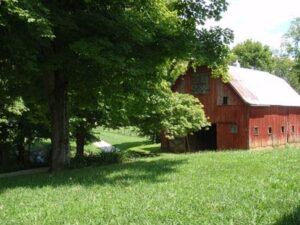
Where to find carpenter bees:
Range
There are hundreds of species of carpenter bees worldwide, but in most of the eastern U.S. there’s only one species – the eastern carpenter bee (Xylocopa virginica). This is the species that stakes out our old barn each year. It can be found from Florida, over to Texas, and all the way up into southern Canada.
Because the eastern carpenter bee is the only species of carpenter bee throughout most of its range, most people drop the “eastern” part of its name and just refer to it as a “carpenter bee.” However, this can sometimes get confusing in the Deep South where there are two species of carpenter bees or when talking to people from other parts of the country (or world) where some of the other species are found instead of our eastern carpenter bee.
Habitat
Carpenter bees can be found in areas where there are lots of flowers for them to feed on and lots of wood for them to nest in. The wood can either be standing dead trees or can be untreated fence posts, buildings, decks, furniture, etc. They have no problem living in close proximity to people. In fact, some studies suggest that carpenter bees may benefit from urbanization and suburban sprawl because of the abundance of potential nesting sites which can be limiting factors in more rural areas.
How to identify the eastern carpenter bee:
Eastern carpenter bees look like a large bumble bee. In fact, they are often mistaken for bumble bees and bumble bees are often mistaken for carpenter bees. The easiest way I know to tell them apart is to look at their abdomen (rear end) and remember the saying, “Bumble bees have a fuzzy fanny. Carpenter bees have a shiny hiney.” You can even tell male eastern carpenter bees from female eastern carpenter bees because the males have a white patch on their foreheads.
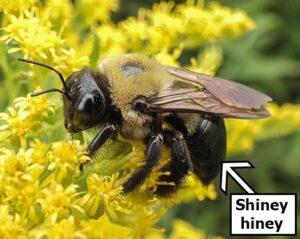
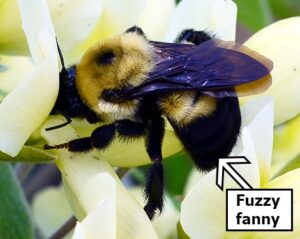
Basic biology and life history:
Diet
Contrary to what is sometimes assumed, carpenter bees don’t eat wood. Instead, they eat pollen and nectar. The adult carpenter bees (both male and female) forage for pollen and nectar from a wide variety of flowers and are important pollinators because of that. While the eastern carpenter bee will visit and use all kinds of different flowers, it has a special relationship with one species in particular.
Special relationship with purple passionflower
The eastern carpenter bee is the primary pollinator of purple passionflower (Passiflora incarnata). The purple passionflower produces nectar near the center of its flower. Many different insects, including other species of bees, are able to access and drink the nectar. But those other insects do little to nothing in the way of pollination for the purple passionflower. That’s because the design of the flower is specifically set up for carpenter bees. (Which I think is fascinating.)
The purple passionflower’s reproductive parts are located on the stalk that sticks up out of the center of the flower. Both the anthers (male parts) and the stigmas (female parts) are positioned at exactly “carpenter bee height” above the flower petals. So, any carpenter bees that are drinking nectar from the center of the flower can’t avoid coming in contact with them. Dipping under an anther results in getting a good brushing of pollen coating their backs. While crawling under a stigma allows any pollen that might be on the carpenter bees’ backs to be picked up and used to fertilize the flower.
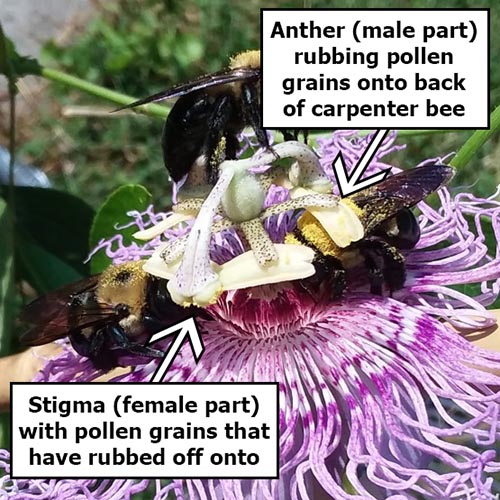
Life cycle
Adult carpenter bees emerge in early spring, usually sometime around mid-March in Kentucky. The males emerge first and begin patrolling likely nesting spots for females. The males are usually the ones that you see hovering in one spot near large wooden structures, like our barn. They are extremely sensitive to movement and will come up to inspect virtually any object that moves through their territory.
It can be kind of intimidating to have a large bee fly right up to you and loudly buzz within a foot of you. But male carpenter bees are completely harmless. They can’t sting because they don’t have a stinger. All they can do is try to chase off intruders and ram them out of the sky if they catch up. Obviously, they can’t ram us out of the sky, but they can (and sometimes will) bump us, which can be disconcerting if you don’t know what’s going on. Standing still will often cause the male carpenter bee to lose interest and return to guarding its territory.

The adult females will emerge a few days after the males. They’ll mate and then begin the nesting process. Although the males will forage for their own food, the females are left to gather all the pollen and nectar they need to stay alive and to feed their young. Because of this, the females are most often found foraging on flowers and zipping back to their nests. The females can sting but rarely do so unless grabbed or otherwise severely threatened.
By midsummer, most of the adults who emerged in the spring will have died. From the time an egg is laid until the pupa metamorphosizes into a new adult carpenter bee is approximately two months. The new adult bees will hang out in the nest for a few weeks where they finish consuming the pollen and nectar stores left by their mother. In the late summer or early fall, they will chew their way out of their nesting tunnels and begin foraging for their own nectar and pollen.
In late fall, they’ll return to their nesting chambers to overwinter. The following spring, they’ll emerge, mate, and start the process over again.
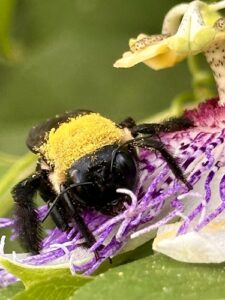
Nesting behavior
Female carpenter bees create nesting sites by chewing tunnels into dead wood. They prefer softer woods such as that of pines or other conifers over harder woods. When they create their tunnels, they chew an almost perfect circle into the side of the piece of wood. This entrance will extend about 1 to 2 body lengths into the wood before turning 90 degrees and continuing either up or down. They don’t eat the wood as they go, instead they push it out of the entrance. In fact, piles of sawdust can be a good indicator of carpenter bee activity even if you don’t see the hole.
Excavating a new tunnel is a slow process. One resource I found estimated that it takes approximately 6 days for a female carpenter bee to excavate one inch of tunnel. Because it takes so much energy and time to create a new tunnel, females will often reuse existing tunnels. They may even add onto an existing tunnel and make it longer. There are reports of nesting tunnels reaching up to 10 feet in length after many years of use. Sometimes the main tunnel will even have branches off of it.
After creating (or claiming) a nesting tunnel, the female gathers a ball of pollen and nectar which she’ll store at the end of the nesting chamber. The ball has to be big enough to sustain her young through its larval, pupal, and newly emerged adult stages. After she has gathered enough pollen and nectar, she’ll lay an egg in the chamber and create a “particle board wall” out of scraps of sawdust and saliva. Then she’ll begin gathering another ball of pollen and nectar to repeat the whole process over and over again until she dies.
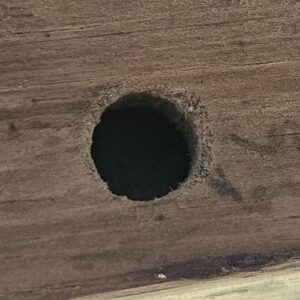
Social or not?
Eastern carpenter bees are considered solitary bees because each mated female creates and provisions her own nest. They aren’t social insects like honey bees or even bumble bees where there is single queen bee whose primary job is to lay eggs, while her young takes care of all the foraging and guarding duties. Instead, female eastern carpenter bees are hardworking, single mothers who are responsible for taking care of everything.
However, that doesn’t always mean that there’s only one female per nest. Sometimes it does, but sometimes it doesn’t. In fact, eastern carpenter bees are sometimes studied as a potential intermediate between solitary bees and more social bees like honey bees or bumble bees.
So, sometimes eastern carpenter bees have a fairly simple and straightforward solitary behavior with one female per nesting tunnel who is responsible for doing absolutely everything. In other cases, there may be multiple adult females per nesting tunnel. Those females can be divided into primary, secondary, and tertiary categories.
When you have a nest with multiple females, there will only be one primary female. She is the one who lays all the eggs and gathers all the pollen and nectar that will be placed with each egg. The secondary and tertiary females are usually nestmates and genetically related to the primary female. (Eastern carpenter bees are extremely good at recognizing their nestmates.)
The secondary females may help with some of the nest guarding but may also relocate frequently to other nesting sites throughout the season. It is thought that they are likely looking for opportunities to become a primary female and take over a nesting tunnel of their own.
The tertiary females don’t appear to do much of anything but hang out in the nesting tunnel. Apparently, they can overwinter for a second time and often become primary females the next year. These tertiary females are the only eastern carpenter bees that can survive two winters.
This nesting behavior with some sites having a single female and others having multiple females seems to be widespread and common in eastern carpenter bees. Observations of both types of nesting behavior have been studied as far south as Georgia and as far north as Canada. I think it’s a pretty fascinating topic that isn’t often talked about. It’s also a great reminder that things in nature aren’t always simple.
How to prevent (or at least discourage) carpenter bee damage
Eastern carpenter bees are important pollinators and play a vital role in the ecosystem. They are also just a fascinating insect with some really interesting behaviors. However, they can be problematic around homes. That’s why, “What should I do about carpenter bees?” is such a common question. It’s also a very valid question because we do need to take care of our homes, in addition to taking care of the pollinators that we attract to our yards. So, let’s talk about a couple of quick and easy things you can do to prevent, or at least discourage, carpenter bee damage, and what to do if neither of those options work.
1) Paint exposed wood
Carpenter bees prefer to build their nesting tunnels in untreated, unstained, unpainted wood. One very easy method for keeping carpenter bees from drilling holes into your wooden structures is to paint or stain the wood. Painting the wood is often reported to have better results than simply staining the wood. But I’ve had luck, at least in the short term, with staining the wood too.
However, once the paint, or stain, starts to wear off, it becomes fair game for the carpenter bees again. So, you do have to keep the maintenance up, but you should have several years before having to worry about it again.
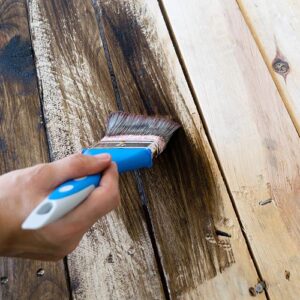
2) Provide more attractive alternatives
Carpenter bees prefer pine and other soft woods. So, providing a scrap piece of untreated, unstained, unpainted, pine lumber can sometimes provide a great alternative nesting site for them.
We learned this trick by accident many years ago, when we were redoing the old, warped back deck at our previous house. A piece of scrap pine lumber was leaned up out of the way and forgotten about. The carpenter bees immediately started using it and ignoring our newly rebuilt and stained deck.
Simply providing a piece of scrap lumber doesn’t always work, especially if you’re trying to discourage them from nesting in something large, like a barn or a log home. But it’s worth a shot for smaller structures like decks or furniture.
What if they’re still causing problems?
So, you’ve tried both suggestions above and it hasn’t made a difference. Now what? Well, now you have to make some choices.
A single hole here or there probably isn’t going to be a big deal or cause any major structural problems unless it begins to let in moisture and causes rot, or the woodpeckers get after the larva, or something like that. If it’s in a place where you aren’t worried about rot, woodpeckers, or anything like that, then you may choose to just not worry about it. You do your thing and let the carpenter bees do their thing.
However, if you have more holes than you are comfortable having or you’re worried about potential secondary issues such as rot or woodpeckers, then it may be time to consider lethal options. Hopefully, that’s not your first choice, because carpenter bees are an important part of the ecosystem. But, we have to protect our homes and properties too and sometimes that means making hard choices.
Remember, we’re trying to find the balancing point between our needs and the needs of the pollinators and wildlife we are trying to attract and support. That balancing point is going to be different for each of us, but it isn’t an “all or nothing” at either extreme. So, try the nonlethal methods for discouraging unwanted carpenter bee nesting activities first. If they don’t work, talk to your local agricultural extension office about the best ways to deal with nuisance carpenter bees in your area.
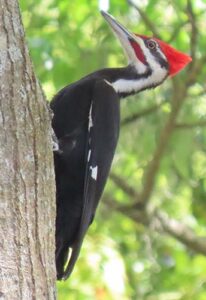
If you would like personalized help creating your own pollinator and wildlife habitat, then we encourage you to check out the Backyard Ecology™ Community.
There’s lots of great “big picture” information available about creating pollinator gardens or larger habitats for pollinators and wildlife. What’s lacking are opportunities to say, “This is what I want to do. This is what I’m struggling with. How do I make it work on my property?”
That’s part of what the Backyard Ecology™ Community offers its members every day.
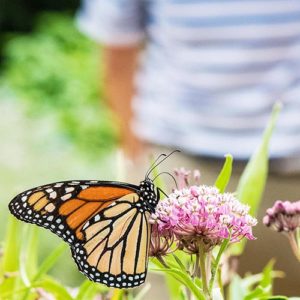
Thank you!
These amazing individuals go above and beyond every month to provide financial support which helps us create so much free content for everyone to enjoy and learn from.
Julie Krygier, Lizabeth, Russel Furnari, Crystal Robinson, Karen Veleta, Kevin B, Sally Mirick, Crystal Dyamonds, Mitchell Bell, Laura Hunt, Sue Ann Barnes, Adrienne Richardson, J. Adam Perkey, Ariel, Cara Flinn, David Todd, LaVonne Fitts, Cathy, Michael, Tom Winner, Eric Fleming, Julie, SB H, Christopher Scully, Craig, Rachel Antonucci, Melissa Egbertson, Switzy, CotswoldsCottageMA, Vilma Fabre, Pia O Nomata, Linda McNees, HerculesBiggerCousin, Patrick Dwyer, Paul Gourley, Lilith Jones, John Master, William Morin, Lori Sadie Ann, Debra, Ayn Zitzman, Han Mad, Isaac Kowis, Cathy Anderson, Betsy Lessels, Reid, and Dave Teare.
Backyard Ecology™: Creating thriving backyard ecosystems that you can enjoy and be proud of
We created Backyard Ecology™ to help you confidently create pollinator and wildlife habitat that you can enjoy and be proud of. Because nature isn’t just “out there.” It’s all around us, including right outside our doors.
Our focus on the eastern U.S. means that the information we share is applicable to you and where you live. Join us as we ignite our curiosity and natural wonder, explore our yards and communities, and improve our local pollinator and wildlife habitat.

Backyard Ecology™’s Guiding Principles:
🦋 Curiosity: Nature is fun, interesting, and worth exploring. We will never know everything. Answers lead to more questions. That’s half the fun.
🦋 Balanced: You don’t have to choose. You can support nature AND have a beautiful property that you can enjoy and be proud of.
🦋 Science informed: Habitat creation and management should be based on the latest scientific research available. This is true regardless of whether you’re working in a small garden or on hundreds of acres.
🦋 Stewardship: Anyone can make a positive difference in the natural world and leave an ecological legacy on their property.

Leave a Reply